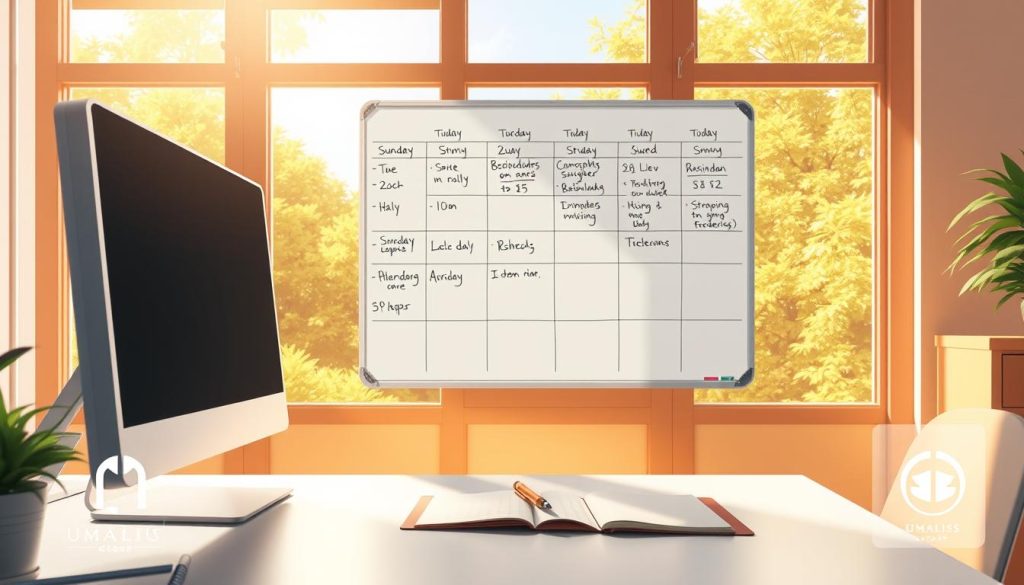Surprising fact: since the pandemic, 41% of workers now pick roles for balance rather than salary, a shift that shows how much priorities have changed.
As an independent professional in France, you juggle client delivery and business growth. Technology and remote setups have blurred the line between office and home, so many people check email after hours or take calls during meals.
We explain practical steps to find balance without harming revenue or trust. You will get leadership tips for setting boundaries, weekly planning ideas to protect your time, and ways to reduce stress while boosting productivity.
We also tie the business case to real costs: replacing an employee can run about £30,000 and take up to 28 weeks to restore full productivity. Our aim is to help you protect your health and your practice with clear, usable guidance.
Table of Contents
Key Takeaways
- Prioritize clear boundaries to protect your time and energy.
- Small weekly routines improve productivity and reduce stress.
- Leadership in your practice sets client expectations and tone.
- Healthier habits lower turnover costs and sustain revenue.
- Find practical tips and data in our work-life balance guide.
Why work-life balance matters right now for independent professionals in France
For freelancers and consultants in France, the blur between home and office has become a business risk. Technology and hybrid norms mean more after-hours messages, ad hoc meetings, and decision fatigue.
« Since the pandemic, 41% of workers now choose work-life balance over salary, »
This Aviva finding shows a shift in expectations. In France, the Right to disconnect signals cultural support for limits on work outside office hours. Even if you are not an employee, you must define your working hours and communication rules to protect your personal life.
Immediate, practical tips:
- Set clear response-time windows and publish them in your email footer.
- Block core meeting hours and reserve no-meeting slots for deep work.
- Use simple signals—service-hour policies or auto-replies—to manage client expectations.
People and employees face similar pressures, but independents lack institutional buffers. Without structure, unmanaged hours increase errors and reduce performance. A healthy work-life approach is not less work; it is smarter scheduling to protect energy, quality, and your reputation.
The business case for a healthy work-life balance
Protecting your time and recovery leads directly to fewer health issues and steadier output. For independent professionals in France, this is a business decision as much as a personal one.
Fewer health problems and better mental health
Long hours harm health: UCL data on over 10,000 participants found white-collar workers who logged three or more extra hours had a 60% higher risk of heart-related problems. Protecting regular hours reduces that risk and keeps you available for clients.
Higher engagement, performance, and productivity
Engagement drives results. Tower Perrin found highly engaged teams posted a 19.2% gain in operating income versus a 32.7% decline for low engagement firms. For a solo practice, clear routines and recovery produce similar lifts in performance and productivity.
Preventing burnout to sustain energy and quality
Burnout eats creative capacity and raises error rates. Oxford Economics shows replacing staff costs about £30,000 and 28 weeks to restore full productivity—an illustration of why retaining clients and contractors matters.
Simple actions: set realistic hours, track overtime, and measure sleep and stress weekly. For practical guidance, see our work-life balance guide.
How to plan your week to find balance without losing billable hours
When you map tasks to energy peaks, you get more done in fewer billable hours. Start by scheduling restorative activities first—treat personal time like a high-priority client. This protects delivery windows and helps you find balance while keeping revenue steady.
Plan ahead: create a weekly template that reserves blocks for deep work, admin, and meetings. Place demanding tasks in your peak energy slots and lighter work in low-energy periods.
Set focused time blocks and align with your energy levels
Use fixed blocks for uninterrupted deep work and protect them like client calls. Turn off notifications, close extra tabs, and use Pomodoro cycles to keep focus.
Embrace how your brain works: reduce multitasking and decision fatigue
Batch similar tasks—proposals, invoices, client updates—to cut context switching. Reserve two short weekly blocks for prospecting and marketing. Protect them as you would any meeting.
- Hard stop ritual: capture loose ends, set tomorrow’s top three, then power down.
- Surge plan: for launches, create a short-term schedule and a clear end date to avoid permanent extended hours.
- Quick metrics: track planned vs actual time weekly to iterate your template every Friday.

| Block | Focus | Duration | When |
|---|---|---|---|
| Deep work | High-value delivery | 2–3 hours | Morning peak |
| Admin & invoicing | Routine tasks | 60–90 min | After lunch |
| Meetings | Client calls | 90–120 min | Afternoon slots |
| Prospecting | Marketing | 2 x 30 min/week | Protected slots |
Set boundaries that respect working hours and protect personal life
Clear rules about when your day ends protect your energy and your clients. Commit to a firm end-of-day time that fits your market and family obligations. When you name that hour, you make recovery a predictable part of your practice.
Commit to ending work at a set time and create shutdown rituals
Adopt a short shutdown ritual: close open items, jot three priorities for tomorrow, then physically power down work devices. This simple pattern signals your brain that the workday is complete.
Use office-hour language in proposals and your email signature. That leadership in communication sets expectations and reduces late-night pings.
Use technology to unplug after hours across devices
Use app blockers during focus windows and tools that mute work notifications after hours. Keep work apps on one device and use a separate personal device to make unplugging straightforward.
France’s Right to disconnect is a useful model. Even if independents are not covered, adopting similar rules—plus on-call slots priced in contracts—protects recovery and clarifies communication.
balancing work and personal life offers templates to state hours and emergency channels. Review availability weekly and adjust when your real hours shift.
Use breaks throughout the day to improve performance and well-being
Tiny intentional pauses can prevent fatigue and keep your productivity steady. Short rests protect energy and reduce errors during a long workday.
Micro-breaks and lunch away from the screen
Dr. Farvah Fatima recommends a short break every 1–2 hours to reset attention and sustain quality. Simple micro-breaks—stand, stretch, look at a distant point, or slow your breathing—take less than a minute and cut mental fatigue.
Tip: eat lunch away from the screen and, when possible, step outside to change context and support mental health.
Taking time off: truly disconnect to recharge
Nearly 70% of workers admit they work while on vacation. To get real recovery, communicate timelines, leave a contingency plan, log out of email, and silence notifications. Schedule at least one longer break block weekly to restore deeper energy.
Mindfulness to check stress and maintain focus
- Use two-minute breathwork or a short body scan to notice tension early.
- Measure perceived energy levels before and after breaks to fine-tune your cadence.
- Normalize “no meetings” slots with clients so expectations match your focus pattern.
Summary: planned breaks throughout the day and intentional time off improve performance and long-term health. We advise you to schedule regular pauses and protect them like any billable hour.
Working from home without blurring work and home life
A clear frame for your workday stops tasks from following you into personal hours. Effective design beats passive hope. Gallup finds many workers value remote options, yet only a third feel they achieve a healthy balance. That gap shows why simple rituals matter.
Create start/end-of-day rituals to frame your workday
Start with a short walk, a clothing cue, or two minutes of journaling to signal focus. These acts tell your brain the workday is beginning.
End with a shutdown ritual: note tomorrow’s top three, close the laptop, switch off the task light. Physical cues make it easier to leave work at work.
Design a dedicated workspace to support focus and recovery
Reserve a consistent chair or corner as your office. Even a small, tidy spot anchors attention and reduces cognitive load.
Keep ergonomics in mind: good posture, minimal clutter, and natural light protect energy during long hours.
- Meetings: batch calls, include 5–10 minute buffers, and protect one meeting-free block daily.
- Schedule deep work in high-energy hours and reserve low-energy slots for lighter tasks.
- Include short breaks every 60–90 minutes to cut fatigue and restore focus.
- Try a co-working day when home distractions pile up to reset productivity without losing flexibility.

Communicate with clients like a leader to protect your time
Clear communication with clients preserves your time and strengthens trust. When you lead conversations about availability, you set the tone for how work fits into the week and protect your energy.
Set expectations on response times, meetings, and days off.
Slack’s Workforce Index shows 37% of desk workers log on outside standard hours at least weekly, and most do so from pressure rather than choice. Publish explicit response windows and preferred channels so clients know when to expect replies.
Practical steps to publish clear standards
- State working hours and days off in contracts and email footers.
- Define response time ranges (e.g., 24–48 hours) and emergency escalation paths that carry a fee.
- Batch meetings on set days, limit durations, and require an agenda to respect time and energy.
Model leadership through your own availability
Lead by example: use delay-send, avoid late-night messages, and acknowledge others’ boundaries. This shows clients and collaborators you value reliable delivery and sustainable hours.
Weekly rituals: hold a brief capacity check with your team or collaborators to prevent silent overload and to renegotiate timelines early when scope shifts. Consistent communication builds trust and helps you maintain balance while meeting expectations.
Work-life balance versus work-life blending in the French context
Independent professionals face a clear choice: preserve separation or accept a blended day where tasks, family and client work mix. Each approach changes how you manage time, expectations and recovery.
Balance emphasizes clear on/off hours and predictable recovery. Blending gives flexibility for errands or staggered work, but it also increases constant availability and hidden pressure.
« Blending can feel like freedom until it becomes a default expectation. »
Right to disconnect and practical limits for independents
France’s Right to disconnect is a cultural signal that off-hour boundaries matter. As an independent, you must self-impose rules that reflect that spirit.
- Not every sector can blend: some mandates fixed hours and physical presence.
- If you blend, set daily “on” and “off” windows and cap evening work as a rare exception.
- Price on-call availability and add SLAs for after-hours requests to cover real costs.
Watch your health: monitor sleep, mood and tension to detect rising stress or early burnout. Many people find a hybrid model — core separation plus limited, intentional blending — protects recovery while preserving autonomy.
Conclusion
Sustaining a freelance practice means protecting your time as carefully as you protect client deliverables.
We recap: a healthy work-life balance and healthy work-life practices are strategic levers that improve performance, productivity, and long-term health. Evidence from UCL and Tower Perrin links structured recovery to better outcomes; Gallup and Slack show remote flexibility alone won’t fix late-hour pressure.
Practical steps to apply this week: plan your days, protect deep work, set clear boundaries, take restorative breaks, and communicate standards to clients. Choose one small change today — a shutdown ritual or a meeting-free block — and review its effect in days.
Protect time as a business asset, watch early burnout signals, and document your operating principles. For templates and further reading, see our work-life balance resource.
FAQ
What practical steps help independent professionals in France protect personal time without losing billable hours?
Start by planning the week: block specific times for client work, admin, and personal activities. Use focused time blocks aligned with your peak energy, and schedule short breaks to sustain concentration. Communicate clear availability to clients and automate boundaries with shared calendars and message auto-replies. This preserves billable productivity while protecting recovery periods.
How can I prevent burnout while keeping my business growing?
Prioritize sleep, regular micro-breaks, and at least one full day off per week. Adopt a shutdown ritual at the end of each workday to separate work from home life. Monitor stress with simple mindfulness checks and redistribute tasks or outsource low-value work when demand spikes. Early prevention maintains energy and quality, which supports steady growth.
What are effective shutdown rituals for working from home?
A reliable ritual can be as simple as closing all work tabs, logging out of professional apps, tidying your workspace, and noting tomorrow’s top three tasks. Follow this with a short physical cue—standing, stretching, or stepping outside—to mark the end of the workday. Consistency trains your mind to switch roles between work and personal time.
How do I set client expectations about response times without appearing unprofessional?
Be proactive and polite: state your usual response window in proposals, email signatures, and at project kick-off. Offer emergency contact procedures for genuine crises and provide alternatives like scheduled calls. Framing limits as part of a professional process reassures clients and reduces reactive interruptions.
What tools and tech habits help me truly unplug after hours?
Use « Do Not Disturb » modes, schedule email delivery, and disable push notifications for non-urgent apps. Implement message templates that set expectations and enable scheduled sending. Where possible, keep one device for personal use and another for work to minimize accidental re-engagement.
How should I plan my week to protect deep work without losing flexibility for clients?
Reserve recurring deep-work blocks on fixed days and communicate those times to clients as unavailable for meetings. Keep a small flexible window for urgent requests and use asynchronous tools (recorded updates, shared documents) to maintain responsiveness without constant context switching.
Which break strategies improve focus during long workdays?
Favor frequent micro-breaks—five minutes every hour—and a real lunch break away from screens. Include brief physical movement and breathing exercises to reset attention. Longer breaks, such as a half-day off, are crucial for cumulative recovery and sustainable performance.
How can independent professionals use mindfulness without adding complexity to their routine?
Integrate very short practices: one-minute breathing checks between tasks, a two-minute body scan at midday, or a mindful walk during a break. These small habits reduce stress, lower decision fatigue, and improve clarity with minimal time cost.
What workspace setup supports separation between work and home life in small living spaces?
Create a dedicated zone—even a corner—with consistent visual cues (desk mat, lamp, plants) and avoid using that area for nonwork activities. Use physical rituals to enter and exit work mode, such as opening blinds in the morning and closing them at day’s end, to reinforce boundaries in limited space.
How does the "right to disconnect" in France affect self-employed professionals?
While the legal framework primarily targets employers, the principle offers useful guidance: set and communicate limits on availability, establish regular offline periods, and adopt contractual clauses that clarify working hours and emergency procedures. These practices protect wellbeing and professional reputation.
What signs indicate I need to change my schedule or delegate work?
Watch for persistent fatigue, decreased quality, missed deadlines, or reduced enjoyment in work. If administrative tasks consume time you could bill, consider outsourcing. Timely adjustments prevent escalation and preserve long-term sustainability.
How can leaders and solo professionals model healthy habits for their clients and peers?
Demonstrate predictable availability, use clear communication about response times, and show respect for others’ offline hours. Sharing simple routines and outcomes normalizes healthy practices and builds a culture that values focused work and recovery.





